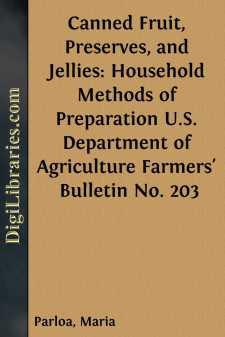Categories
- Antiques & Collectibles 13
- Architecture 36
- Art 48
- Bibles 22
- Biography & Autobiography 813
- Body, Mind & Spirit 142
- Business & Economics 28
- Children's Books 15
- Children's Fiction 12
- Computers 4
- Cooking 94
- Crafts & Hobbies 4
- Drama 346
- Education 46
- Family & Relationships 57
- Fiction 11828
- Games 19
- Gardening 17
- Health & Fitness 34
- History 1377
- House & Home 1
- Humor 147
- Juvenile Fiction 1873
- Juvenile Nonfiction 202
- Language Arts & Disciplines 88
- Law 16
- Literary Collections 686
- Literary Criticism 179
- Mathematics 13
- Medical 41
- Music 40
- Nature 179
- Non-Classifiable 1768
- Performing Arts 7
- Periodicals 1453
- Philosophy 64
- Photography 2
- Poetry 896
- Political Science 203
- Psychology 42
- Reference 154
- Religion 513
- Science 126
- Self-Help 84
- Social Science 81
- Sports & Recreation 34
- Study Aids 3
- Technology & Engineering 59
- Transportation 23
- Travel 463
- True Crime 29
Canned Fruit, Preserves, and Jellies: Household Methods of Preparation U.S. Department of Agriculture Farmers' Bulletin No. 203
by: Maria Parloa
Categories:
Description:
Excerpt
INTRODUCTION.
The common fruits, because of their low nutritive value, are not, as a rule, estimated at their real worth as food. Fruit has great dietetic value and should be used generously and wisely, both fresh and cooked. Fruits supply a variety of flavors, sugar, acids, and a necessary waste or bulky material for aiding in intestinal movement. They are generally rich in potash and soda salts and other minerals. Most fresh fruits are cooling and refreshing. The vegetable acids have a solvent power on the nutrients and are an aid to digestion when not taken in excess.
Fruit and fruit juices keep the blood in a healthy condition when the supply of fresh meat, fish, and vegetables is limited and salt or smoked meats constitute the chief elements of diet. Fresh fruit is generally more appetizing and refreshing than cooked. For this reason it is often eaten in too large quantities, and frequently when underripe or overripe; but when of good quality and eaten in moderate quantities it promotes healthy intestinal action and rarely hurts anyone.
If eaten immoderately, uncooked fruit is apt to induce intestinal disturbances. If eaten unripe, it often causes stomach and intestinal irritation; overripe, it has a tendency to ferment in the alimentary canal. Cooking changes the character and flavor of fruit, and while the product is not so cooling and refreshing as in the raw state, it can, as a rule, be eaten with less danger of causing stomach or intestinal trouble. If sugar be added to the cooked fruit, the nutritive value will be increased. A large quantity of sugar spoils the flavor of the fruit and is likely to make it less easily digested.
Nowhere is there greater need of a generous supply of fruit than on the farm, where the diet is apt to be restricted in variety because of the distance from markets. Every farmer should raise a generous supply of the kinds of fruit that can be grown in his locality. Wives and daughters on the farms should find pleasure in serving these fruits in the most healthful and tempting form. There are a large number of simple, dainty desserts that can be prepared with fruit and without much labor. Such desserts should leave the pie as an occasional luxury instead of allowing it to be considered a daily necessity.
In the season when each kind of fruit is plentiful and at its best a generous supply should be canned for the season when both fruit and fresh vegetables are scarce. A great deal of the fruit should be canned with little or no sugar, that it may be as nearly as possible in the condition of fresh fruit. This is the best condition for cooking purposes. A supply of glass jars does cost something, but that item of expense should be charged to future years, as with proper care the breaking of a jar need be a rare occurrence. If there be an abundance of grapes and small, juicy fruits, plenty of juice should be canned or bottled for refreshing drinks throughout the year. Remember that the fruit and juice are not luxuries, but an addition to the dietary that will mean better health for the members of the family and greater economy in the cost of the table....








